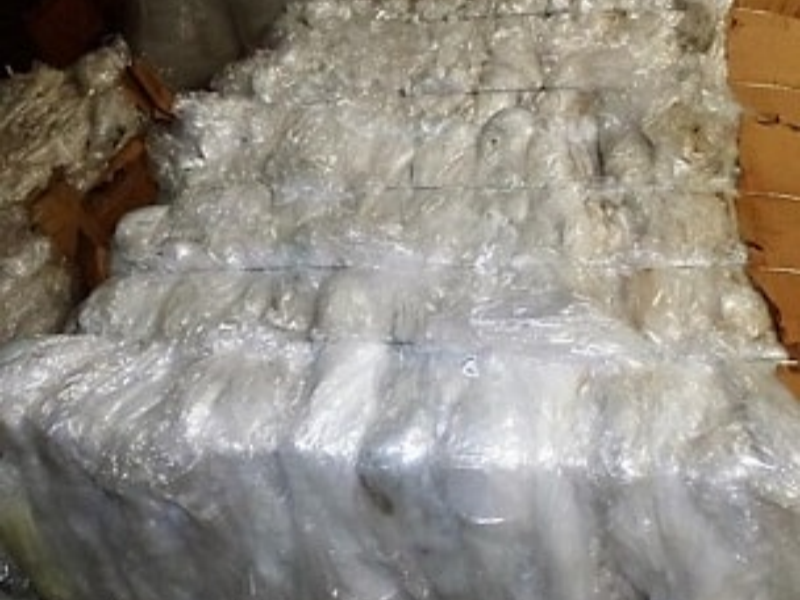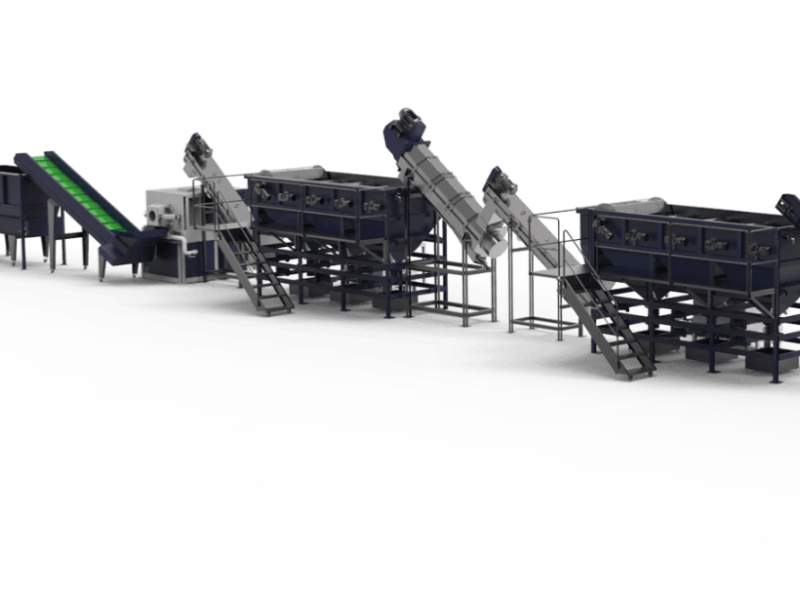JIANGSU KITECH MACHINERY CO.,LTD
Not only a last cleaning stage, rinsing is a vital quality gate determining the purity, processability, and market value of recycled plastic in every recycling wash line. Incomplete rinsing leaves behind residual contamination that degrades the physical, chemical, and aesthetic features of recovered PET, PE, and PP products.
Residual chemicals including oils, cleaning agents, and fine particles are left withplastic flakes or pellets occasionally when the rinsing section of a recycling wash line is poorly made or not consistently maintained. Among the numerous material qualities these contaminants destroy are:
| Contaminant Type | Effect on Recycled Plastic |
| Oil residues | Causes discoloration, stickiness, and poor adhesion in downstream applications |
| Detergent remnants | Leads to unwanted odor, foaming during remelting, and surface blemishes |
| Dust and fine debris | Results in black spots, brittleness, and extruder filter blockage |
Such effects directly reduce the usability of the final product in sensitive industries like packaging, automotive, and textiles. For instance, food-grade rPET requires strict odor and color standards which are unattainable without effective rinsing.
12% of PET pellets intended for thermoforming trays were rejected by a middle range recycling facility in Southeast Asia. Further investigation showed that their recycling wash line's final rinsing tank lacked adequate filtration and agitation. A European client rejected the delivery because of yellowing and offodors from the leftover detergent. Following inline conductivity monitoring and pressurized hot water wash, the rejection rate dropped below 2%.
Avoiding downstream problems calls for constant every step in a high-throughput recycle washing line. The primary reasons for rinsing include:
·This signals the end of the cleaning process; any leftovers at this point go straight into pelletizing or extrusion.
·It confirms market conformity; insufficient washing may reject food contact or export use material.
·Less residue protects downstream equipment by reducing extruder filter and hot melt pump wear.
Therefore, improving the washing performance of your recycle line is not optional; rather, it is absolutely necessary for long-term customer satisfaction, steady pellet quality, and sustainable operation.
2. Common Causes of Incomplete Rinsing and Diagnostic Methods
Lack of rinsing is among the most frequently observed issues in a recycle washing line; sometimes it produces subpar recycled pellets and fouling of subsequent equipment. Finding the root reasons of poor rinsing efficiency is important for maintenance engineers as well as plant managers. This section groups the most often seen technical problems and offers fast, reliable detection methods in actual industrial contexts.
Many process-related and mechanical components on a recycle wash line can compromise insufficient rinsing ability. These cover poor flow dynamics, erratic temperature control, and incorrectly constructed return flow systems.
| Cause | Description |
| Low spray pressure | Results in insufficient impact force to dislodge surface residues |
| Weak tank agitation | Allows heavy particles or detergent to settle without being flushed out |
| Inadequate water temperature | Limits the solubility of oils and surfactants, especially in winter conditions |
| Improper dirty water return design | Reintroduces contaminants from rinse tank into upstream sections |
| Overloaded rinse capacity | Causes water quality degradation due to excessive plastic feed rate |
Without addressing these structural issues, even an otherwise well-configured recycle washing line will struggle to meet quality targets.
To resolve rinsing failures effectively, operators should apply quick and practical testing methods. These allow for on-site evaluation without interrupting the overall operation of the recycle washing line.
| Diagnostic Method | What It Detects |
| Water sample residue testing | Checks for presence of oil, foam, and particulates after final rinse |
| Conductivity measurement | Identifies detergent buildup in rinse water |
| Visual flake inspection | Reveals surface impurities not removed by rinsing |
| Smell or odor testing | Detects residual chemical agents, especially in PET or PE flakes |
| Rinse water flow rate measurement | Ensures consistent hydraulic pressure across all nozzles or jets |
Regular use of these diagnostic tools helps engineers detect performance drops in the recycle washing line before they result in batch-wide quality defects.
An ideal approach for industrial factories is to run a weekly rinse inspection on the recycling washing line. This entails:
·Quantifying input/output rinsing water contamination
·Recording tank temperature and nozzle pressure
·Checking all changes from intended water replacement cycles
Through earlystage diagnostics and continuous monitoring, manufacturers may assure highyield, lowdefect recycled plastic production by maintaining constant rinsing quality on their recycle washing line.

Attaining great performance rinsing in a recycle washing line depends mostly on the accurate settings of key process parameters. Even the finest designed system will fall short if operating parameters are not optimized. This section provides realistic suggestions on altering significant rinsing settings to raise final product cleanliness and ensure consistent plastic pellet quality.
The following table outlines the recommended engineering ranges for major rinsing module parameters in a recycle washing line:
| Parameter | Recommended Range | Function and Impact |
| Spray water pressure | 0.3 – 0.5 MPa | Ensures strong contact force to remove surface contaminants and detergent residues |
| Rinse water temperature | 40 – 60°C | Enhances oil solubility and accelerates chemical breakdown of organic residues |
| Filtration accuracy | Less than 80 μm | Prevents fine particles from recirculating in rinse loops |
These settings serve as a baseline for most PET, PE, and PP processing in industrial-scale recycle washing line operations.
Major effects come from equipment configuration and hydraulic design; just setting right settings is not enough. Consider these technical modifications to enhance rinsing performance:
·To increase water turnover and halt tank residue buildup, install bigger capacity pumps and so boost the circulation flow rate.
·Insert inline filters between rinse cycles to remove fine particles before water re-use.
·Use fanshaped nozzles aimed at 45 degrees to increase material turbulence and maximize surface impact.
Using these measures will enable recycling washing line operators to assure that water flows are not only abundant but also precisely directed for thorough cleaning.
Realtime monitoring sensors should be installed in the rinse part of the recycle wash line for steady rinse quality. These could include:
·Pressure gauges at nozzle manifolds
·Temperature sensors in rinsing basins
·Turbidity meters on water recirculating lines
Such systems let operators dynamically modify process parameters, hence removing manual guesswork and minimizing quality variance risk.
Implementing the above optimizations delivers measurable improvements in rinsing effectiveness:
| Improvement Area | Expected Benefit |
| Water pressure control | 20–30% increase in contaminant removal |
| Temperature stability | Reduced residual oil by up to 40% |
| Filtration enhancement | 50% reduction in visible particulate contamination |
Used together, these changes can greatly improve the cleaning phase of your recycle washing line, guaranteeing better compliance with enduse application guidelines and higher-quality recycled polymers.
For instance, PET bottles, PE films, and PP woven bags all react differently to washing techniques in a recycle washing line. Every material has distinct physical and chemical characteristics that determine how it must be washed, rinsed, and kept under control. Using a onesizefitsall rinsing method can result in poor cleaning and inefficiencies, therefore lowering the general quality of recycled goods.
| Material Type | Rinsing Challenge | Recommended Approach |
| PET bottles | Sensitive to heat; risk of warping or crystallization | Use controlled-temperature hot water (max 60°C); moderate agitation |
| PE films | Lightweight and floats on water; tends to trap dirt between folds | Add paddle agitation or rotary stirring; increase rinse cycle duration |
| PP woven bags | Rough texture retains embedded particles; higher density contaminants | Employ high-pressure sprays; pre-shredding for better exposure |
Without accommodating these needs, a recycle washing line may either under-clean the material or damage its integrity, especially in high-throughput applications.
Knowledge of these differences is required for customizing rinse modules and raising the flexibility of your recycle laundry line.
Over mixed input, a flexible rinsing system plan can greatly improve rinsing efficiency. Recommended modifications consist of:
·Modular tank design: distinct rinse loops for PET and PE/PP streams
· Adjustable spray systems feature variable pressure nozzles for difficult PP leftovers.
·Material-specific water temperature management: committed heaters for PET lines
Introducing variable and partitioned rinsing pathways helps recycle wash line operators to handle a wider range of feedstock while maintaining cleaning effectiveness.
Customizing washing conditions for certain plastic types not only increases cleanliness but also increases downstream yield and equipment life. Consider, for example:
·PET bottles washed under temperature regulation help to minimize crystallization flaws in pelletizing.
·Strong agitation PE movies stop later screen congestion.
· Pressurized rinse and pre-soaked PP bags enhance the mechanical characteristics of recyclate.
Proper setup of rinsing procedures according to material type guarantees that even when processing mixed postconsumer garbage, a recycle wash line produces steady, highpurity results.
Modernizing the rinse phase of a recycle washing line with stateoftheart equipment and smart monitoring systems can significantly improve cleaning efficiency, reduce water use, and restrict manual intervention. Given the ever more demanding requirements for recycled material purity, antiquated rinsing systems often serve as the bottleneck in production efficiency.
The most recent rinsing technique developments are examined here along with how digital control systems could offer your recycle washing line long-term operating benefits.

Several equipment innovations have emerged to address rinsing inefficiencies in conventional recycle washing line setups. These solutions aim to increase surface agitation, improve particle separation, and automate water management.
| Equipment Type | Function |
| Fully enclosed rotary rinsing tank | Provides 360° dynamic agitation for high-contact surface cleaning |
| Ultrasonic-assisted rinse module | Uses vibration to break down microscopic residues and enhance detachment |
| Integrated water filtration loop | Continuously filters and recycles rinse water, reducing contamination levels |
These equipment upgrades are modular and can be integrated into existing recycle washing line systems without requiring a full redesign.
Digital recycling methods are getting more and more prevalent. Among the recently created smart washing modules are:
·PLC controlled temperature and flow
·Sensors for water quality (pH, turbidity, conductivity)
·Systems for tank replacement cycles and maintenance autalert
These systems allow plant managers to dynamically control rinse water pressure depending on actual contamination levels and modify changeover frequency.
| Feature | Operational Benefit |
| Real-time water quality feedback | Ensures consistent rinsing performance, especially during input variation |
| Automated system alerts | Reduces downtime by predicting clogs and pump issues |
| Historical data logging | Enables long-term optimization and quality audits |
By embedding these digital tools into the recycle washing line, facilities gain better control over process stability and energy efficiency—while reducing over-rinsing and excessive water use.
Though smart washing systems appear to have a high initial expense, the return is clear through:
·Lower rates of rejection brought about by cleaner plastic granules
·Reduced water and energy costs
·Predictive monitoring lowers maintenance frequency.
When used with enough operator instruction, these systems make the recycle washing line more sustainable, expandable, and in accordance with worldwide recycling norms.
Resolving insufficient rinsing in a recycle wash line requires a strong understanding of both the materialspecific concerns and the technical technique. By admitting the negative effects of insufficient rinsing on recycled material quality, accurately pinpointing root causes, and implementing particular changes in water pressure, temperature, and system design, producers may significantly improve cleaning effectiveness.
Moreover, changing rinse techniques for different plastic kinds and including intelligent monitoring systems guarantees long-term stability and operational consistency. For professional recycling companies striving for great output quality and regulatory compliance, resolving rinsing inefficiencies is essential—it is not optional. Using the right technique and technology, your recycle washing line can consistently generate less downtime, less trash, and cleaner, better quality recycled plastics.